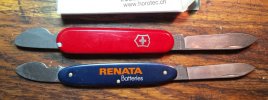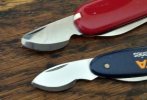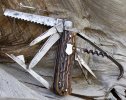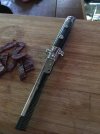- Joined
- May 10, 2017
- Messages
- 736
Hemming and hawing as to whether this is a topic for the porch or better served in the general knife discussion. Porch won out since it seems to me the vast majority of "modern knives" are not designed with any specific task to do and these knives are definitely loaded with tradition. So....
Anyone care to share picts. and descriptions of knives that were specifically made for specific tasks or are unique in their construction for doing specific or traditional tasks? Not talking about the EDC you always carry to cut open the box with your latest knife to arrive in the mail, or only use it to cut your sandwich at lunch. I'm talking about knives built or modified for specific, or unique tasks. No, pictures of a "skinning" knife, "Pen" knife, or "Zombie killer" don't qualify. If you post a zombie knife, hopefully the residents of the porch will roast you and use the leftover grease to lube a slip joint or two since that doesn't belong here anyway. Probably easier to demo the concept though. Here are 3 knives from my collection that are all very unique, traditional, and purpose built.
Probably easier to demo the concept though. Here are 3 knives from my collection that are all very unique, traditional, and purpose built.
Starting off. German Falconer's Knife from Hubertus in Solingen. On first glance, looks like a traditional hunting knife in the German style known as a nicker. However, take note of the notch cut in the edge a inch or two from the tip. The blade edge runs ONLY from the notch to the tip. No sharp edge behind the notch at all.
The reasoning behind this mostly dull blade is it allows the falconer to insert the knife between the talons of his bird to dispatch the prey, without injuring his bird's talons. Loved the design concept and the knife has a classic look anyway so I grabbed it.
Now I need to get a falcon....

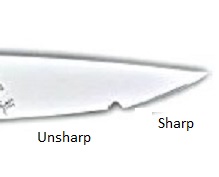
Second knife I have is a "Melon Tester", this particular one made by Rough Rider with bone scales. Oddly enough, the website and sales info I bought it from listed the knife as a melon tester and have since seen other knives designed and called the same. However, Rough Rider's packaging of the knife when it arrived calls it a "Pig Sticker" and has no mention of melons anywhere on the box.
The photo may look like I went crazy with photo shop and stretched the picture out, but it really is that long and thin. The purpose being to have a pocket knife that can effectively slice into a melon. Blade is 4.5" long, OAL is 9.875". Overall diameter of the handle is not much bigger than a Bic pen, but probably can't be called a pen knife.
Due to it's construction and geometry, this knife could break very easily with any side to side motion. The strength if you want to call it that is only vertical. So cutting into a melon, straight down and around. This is definitely not a cut and pry design.

So the two knives above are knives I discovered over the last couple of years through BF and my jumping into this quicksand of a hobby even though I knew where my OCD could take it.
The last knife I have known about since I was 5-6 years old. As a certified and registered fishing and gun nut back then - even more back then - I would jump at the chance to watch any hunting or fishing shows on TV. This was the days of "American Sportsman" with Curt Gowdy still on broadcast TV, (Still remember the episode of bird hunting with Bing Crosby and Phil Harris) and similar outdoors or adventure movies playing in our local theaters at times.
This is the Alaskan Ulu of the Inuit. This particular one is made by Rough Rider and has a chisel grind. The wood below it is a stand to store the knife on.
This hunk of sheet steel fastened to a hunk of wood is the original 1 bladed SAK. The Inuit use this for skinning and butchering game of any size from bunnies and salmon, to caribou and walrus. It is used for cutting and slicing anything, preparing meals, making clothes, or giving haircuts. And when combined with a similarly curved bowl, it becomes one of the first food processors ever made where you can mince, slice, dice, chop or crop anything and everything. About the only thing they needed a different knife for was a long bladed knife to cut snow blocks for an igloo.
Show what's in your collection that's unique, purpose built and has a story to tell or a design to reveal?
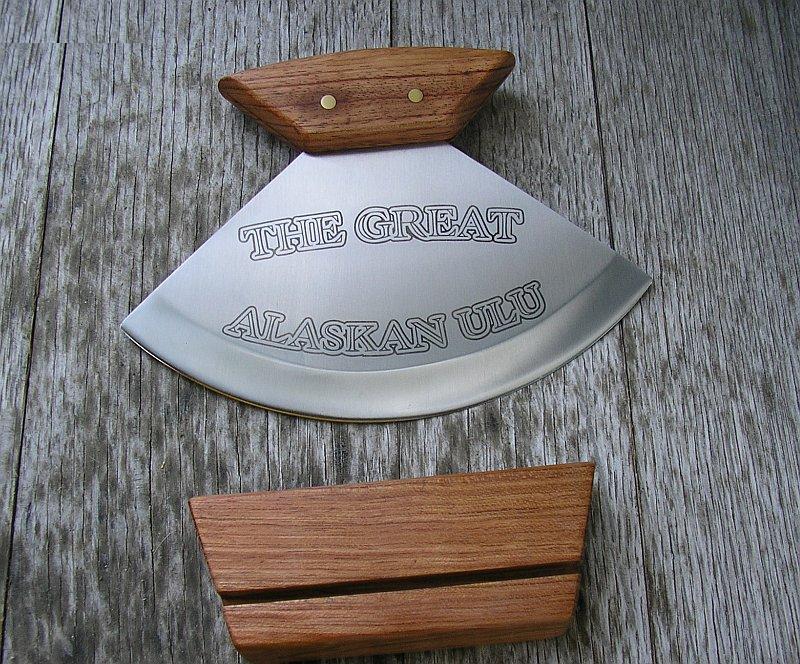
Anyone care to share picts. and descriptions of knives that were specifically made for specific tasks or are unique in their construction for doing specific or traditional tasks? Not talking about the EDC you always carry to cut open the box with your latest knife to arrive in the mail, or only use it to cut your sandwich at lunch. I'm talking about knives built or modified for specific, or unique tasks. No, pictures of a "skinning" knife, "Pen" knife, or "Zombie killer" don't qualify. If you post a zombie knife, hopefully the residents of the porch will roast you and use the leftover grease to lube a slip joint or two since that doesn't belong here anyway.
Starting off. German Falconer's Knife from Hubertus in Solingen. On first glance, looks like a traditional hunting knife in the German style known as a nicker. However, take note of the notch cut in the edge a inch or two from the tip. The blade edge runs ONLY from the notch to the tip. No sharp edge behind the notch at all.
The reasoning behind this mostly dull blade is it allows the falconer to insert the knife between the talons of his bird to dispatch the prey, without injuring his bird's talons. Loved the design concept and the knife has a classic look anyway so I grabbed it.
Now I need to get a falcon....


Second knife I have is a "Melon Tester", this particular one made by Rough Rider with bone scales. Oddly enough, the website and sales info I bought it from listed the knife as a melon tester and have since seen other knives designed and called the same. However, Rough Rider's packaging of the knife when it arrived calls it a "Pig Sticker" and has no mention of melons anywhere on the box.
The photo may look like I went crazy with photo shop and stretched the picture out, but it really is that long and thin. The purpose being to have a pocket knife that can effectively slice into a melon. Blade is 4.5" long, OAL is 9.875". Overall diameter of the handle is not much bigger than a Bic pen, but probably can't be called a pen knife.
Due to it's construction and geometry, this knife could break very easily with any side to side motion. The strength if you want to call it that is only vertical. So cutting into a melon, straight down and around. This is definitely not a cut and pry design.

So the two knives above are knives I discovered over the last couple of years through BF and my jumping into this quicksand of a hobby even though I knew where my OCD could take it.
The last knife I have known about since I was 5-6 years old. As a certified and registered fishing and gun nut back then - even more back then - I would jump at the chance to watch any hunting or fishing shows on TV. This was the days of "American Sportsman" with Curt Gowdy still on broadcast TV, (Still remember the episode of bird hunting with Bing Crosby and Phil Harris) and similar outdoors or adventure movies playing in our local theaters at times.
This is the Alaskan Ulu of the Inuit. This particular one is made by Rough Rider and has a chisel grind. The wood below it is a stand to store the knife on.
This hunk of sheet steel fastened to a hunk of wood is the original 1 bladed SAK. The Inuit use this for skinning and butchering game of any size from bunnies and salmon, to caribou and walrus. It is used for cutting and slicing anything, preparing meals, making clothes, or giving haircuts. And when combined with a similarly curved bowl, it becomes one of the first food processors ever made where you can mince, slice, dice, chop or crop anything and everything. About the only thing they needed a different knife for was a long bladed knife to cut snow blocks for an igloo.
Show what's in your collection that's unique, purpose built and has a story to tell or a design to reveal?




